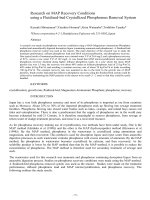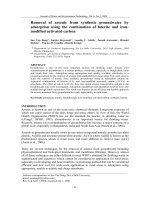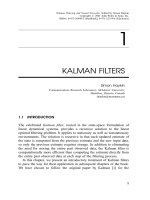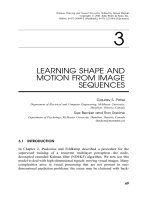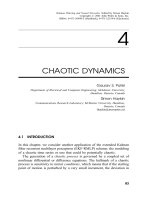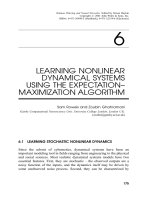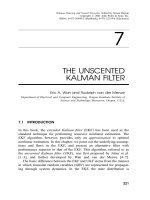Context-aware hand poses classifying on images and video-sequences using a combination of wavelet transforms, PCA and neural networks
Bạn đang xem bản rút gọn của tài liệu. Xem và tải ngay bản đầy đủ của tài liệu tại đây (1.37 MB, 7 trang )
<span class='text_page_counter'>(1)</span><div class='page_container' data-page=1>
<b>Context-aware hand poses classifying on images and </b>
<b>video-sequences using a combination of wavelet </b>
<b>transforms, PCA and neural networks </b>
Phan Ngoc Hoang and Bui Thi Thu Trang*
Ba Ria-Vung Tau University, 80 Truong Cong Dinh street, Ward 3, Vung Tau city, Ba Ria-Vung Tau province, Vietnam
<b>Abstract </b>
In this paper we propose novel context-aware algorithms for hand poses classifying on images and video-sequences. The
proposed hand poses classifying on images algorithm based on Viola-Jones method, wavelet transform, PCA and neural
networks. On the first step, the Viola-Jones method is used to find the location of hand pose on images. Then, on the
second step, the features of hand pose are extracted using combination of wavelet transform and PCA. Finally, on the last
step, these extracted features are classified by multi-layer feed-forward neural networks. The proposed hand poses
classifying on video-sequences algorithm based on the combination of CAMShift algorithm and proposed hand poses
classifying on images algorithm. The experimental results show that the proposed algorithms effectively classify the hand
pose in difference light contrast conditions and compete with state-of-the-art algorithms.
<b>Keywords: Hand poses classifying, image processing, video processing, method Viola-Jones, CAMShift algorithm, wavelet transform, </b>
PCA, neural networks.
Received on 06 April 2017, accepted on 25 May 2017, published on 06 July 2017
Copyright © 2017 Phan Ngoc Hoang and Bui Thi Thu Trang, licensed to EAI. This is an open access article distributed
under the terms of the Creative Commons Attribution licence ( which permits
unlimited use, distribution and reproduction in any medium so long as the original work is properly cited.
doi: 10.4108/eai.6-7-2017.152758
*
Email:,
<b>1. Introduction</b>
Hand gesture recognition is one of the most difficult and
required task in the field of image processing and
computer vision. The hand gesture recognition systems
are used to classify specific human hand gesture to
transfer information or to manage devices, such as
computers, televisions, etc. In this paper, the hand pose
classifying on images and on video-sequences, which is
main subtask of hand gesture recognition, is considered.
Classification hand pose on images can be done based
on these following steps:
<b>1. Detecting the location of hand pose on images;</b>
<b>2. Extracting the features of detected hand pose;</b>
<b>3. Classifying hand pose using extracted features.</b>
Because of high processing speed and effectiveness,
method Viola-Jones becomes one of the most used object
detection methods. So, to detect the location of hand pose
on images we use method Viola-Jones. This method based
on three ingredients to enable fast and accurate object
detection: the integral image for feature detection,
Adaboost for feature selection and an attentional cascade
for efficient computational resource allocation. These
ingredients allow method can perform the object detection
in real time [1–4].
The next step is extracting features of detected hand
pose. In order to extract image features, wavelet transform
is one of the most effective methods. It enables to obtain
the necessary information about the image and it is also
can be very quickly calculated. The experimental results
of image classification algorithms [5–10] showed that
images, features of which extracted by using wavelet
transform, were classified with 76–99.7% accuracy rate.
In the algorithms [4, 11–20] wavelet transform is
effectively used to solve the task of pattern recognition on
</div>
<span class='text_page_counter'>(2)</span><div class='page_container' data-page=2>
noisy images. In this case, the objects were recognized
with 90–98.5% accuracy rate.
Besides the experimental results of algorithms [4, 16–
20] showed that using combination of wavelet transform,
PCA and neural networks gave more effective
performance of object recognition. In these algorithms,
neural networks were used to recognize objects based on
their features, which extracted by using the combination
of wavelet transform and PCA.
Thus, using the combination of Viola-Jones method,
wavelet transform, PCA and neural networks is
perspective solution for development of novel
context-aware hand pose classifying algorithm on images. In this
paper we propose a novel context-aware algorithm for
hand pose classifying based on combination of
Viola-Jones method, wavelet transform, PCA and neural
networks. In this case, the context is any information
about an image such as: image light condition, contour,
noise and so on.
Classification hand pose on video-sequences can be
done based on these following steps:
<b>1. Detecting the location of hand pose on video-frame;</b>
<b>2. Tracking hand pose on video frame, used when hand</b>
pose is detected on previous frame;
<b>3. Extracting the features of detected (tracked) hand</b>
pose;
<b>4. Classifying hand pose using extracted features.</b>
In 1998, Harry Bradsky created the algorithm
CAMShift (Continuously Adaptive MeanShift) [26],
which based on color information was able to effectively
track objects in real time. So in this paper, we propose
hand pose classifying algorithm on video-sequences based
on combination of CAMShift algorithm and proposed
hand pose classifying algorithm on images.
<b>2. Proposed hand pose classifying</b>
<b>algorithm on images </b>
The proposed hand pose classifying algorithm on images
consists of following main steps:
<b>1. Finding the hand pose location on image based on</b>
Viola-Jones method (Fig. 1);
<b>Figure 1. Process of extracting features of hand </b>
poses
<b>2. Retrieving the features of hand pose using wavelet</b>
transform (Fig. 1);
<b>3. Reducing dimension of extracted features vector</b>
based on PCA (Fig. 1);
<b>4. Training neural networks using obtained feature</b>
vectors (Fig. 2);
<b>5. Classifying hand pose based on obtained feature</b>
vectors and trained neural networks (Fig. 3).
<b>Figure 2. Process of training neural networks </b>
<b>Figure 3. Process of classifying hand poses </b>
2.1. Finding hand pose location using
Viola-Jones Method
This method was developed and proposed in 2001 by Paul
Viola and Michael Jones, and it is still effective to detect
object in digital images and videos in real-time [1, 2].
Using simple cascade classifier, which is the feature
detector instead of one complex classifier, is the main
idea of this method. Based on this idea, it enables to
construct a detector, which can work in real time.
<b>Integral image </b>
In Viola-Jones method, integral image is used to
rapidly compute rectangle features. The integral image is
widely used in other methods, such as wavelet transforms,
SURF, Haar filtering and etc. [21]. Pixel value of the
<i>integral image at location (x, y) contains the sum of pixels </i>
<i>above and to the left of (x, y) and is computed by formula </i>
(1).
,
( , ) ( , ),
<i>x x y</i> <i>y</i>
<i>I x y</i> <i>i x y</i>
<b>(1) </b>
<i>where I(x, y) is value of integral image pixel (x, y); i(x, y) </i>
<i>– intensity of original image pixel (x, y). Each pixel value</i>
<i>of integral image I(x, y) is sum of the original pixels from </i>
<i>i(0, 0) to i(x, y). Time of computation of integral image </i>
matrix depends on the number of pixels of original image.
Value of each pixel of integral image can be computed by
formula (2):
, ( , ) ( 1, 1) ( , 1) ( 1, ).
<i>I x y</i> <i>i x y</i> <i>I x</i> <i>y</i> <i>I x y</i> <i>I x</i> <i>y</i> <b><sub>(2) </sub></b>
<b>Haar-like features </b>
</div>
<span class='text_page_counter'>(3)</span><div class='page_container' data-page=3>
features called Haar-like features. A Haar-like feature
considers adjacent rectangular regions at a specific
location in a detection window, sums up the pixel
intensities in each region and calculates the difference
between these sums.
In the detection phase of the Viola–Jones object
detection framework, a window of the target size is
moved over the input image, and for each subsection of
the image the Haar-like feature is calculated. This
difference is then compared to a learned threshold that
separates non-objects from objects. Because such a
Haar-like feature is only a weak learner or classifier (its
detection quality is slightly better than random guessing)
a large number of Haar-like features are necessary to
describe an object with sufficient accuracy. Examples of
Haar-like features are presented in Fig. 4.
<b>Figure 4. Examples of Haar-like features </b>
<b>Learning classification using Adaboost </b>
Boosting is a machine learning meta-algorithm for
performing supervised learning. Boosting is based on the
question posed by Kearns [23]: can a set of weak learners
create a single strong learner? A weak learner is defined
to be a classifier which is only slightly correlated with the
true classification (it can label examples better than
random guessing). In contrast, a strong learner is a
classifier that is arbitrarily well-correlated with the true
classification.
Schapire's affirmative answer to Kearns' question has
had significant ramifications in machine learning and
statistics, most notably leading to the development of
boosting [24].
For each feature, the weak learner determines the
optimal threshold classification function, such that the
minimum number of examples is misclassified. A weak
<i>classifier hj(x) thus consist of a feature fj, a threshold θj </i>
<i>and a parity pj indicating the direction of the inequality </i>
sign (formula 3):
1, ( )
( ) ,
0, otherwise
<i>j j</i> <i>j j</i>
<i>j</i>
<i>if p f</i> <i>z</i> <i>p</i>
<i>h z</i>
<b>(3) </b>
<i>where z is a 24×24 pixel sub-window of an image. </i>
Development of this approach was development more
perfect family algorithms of a boosting – AdaBoost, short
for Adaptive Boosting, is a machine learning algorithm,
formulated by Yoav Freund and Robert Schapire. It is a
meta-algorithm, and can be used in conjunction with
many other learning algorithms to improve their
performance. AdaBoost is adaptive in the sense that
subsequent classifiers built are tweaked in favour of those
instances misclassified by previous classifiers.
For combining increasingly more complex classifier in
a “cascade” which allows background regions of the
image to be quickly discarded while spending more
computation on promising object-like regions.
2.2. Extracting hand pose features using
Wavelet transforms
By using wavelet transform to extract image features, we
will obtain the necessary information about the image.
Besides we can also quickly calculate the wavelet
transform. So wavelet transform becomes one of the most
effective methods, which are used to extract image
features to classify (recognize) objects [4–20].
In this paper, after hand pose location in image is
found by using method Viola-Jones, the Haar and
Daubechies wavelet transforms are used to extract hand
pose image features. The process of extracting hand pose
features by using wavelet transform works as follows.
Firstly, the hand pose image is resized to 64×64 pixels.
Then we apply wavelet transform to obtained image and
extract the low-frequency wavelet coefficients. In the
result, we have matrix that consists of 32×32 = 1024
low-frequency wavelet coefficients (Fig. 5).
<b>Figure 5. Retrieving hand pose features using </b>
wavelet transform
2.3. Extracting hand pose features using
Wavelet transforms
Before classifying by neural networks, dimension of hand
pose feature vector is reduced. In this paper, PCA is used
to solve this task. At first, eigenspace for hand poses
<i>(eigenhandpose) will be created using M images of hand </i>
poses. The process of creating hand pose eigenspace is
carried out as follows.
In first step, the process of extracting features is
<i>applied to each of M images. After that we obtain a set of </i>
1,..., <i>M</i>
<i>I</i> <i>I</i> feature vectors. Then we form the mean vector,
the value of each element of which is calculated by the
formula (4):
1
1
.
<i>M</i>
<i>avg</i> <i>n</i>
<i>n</i>
<i>I</i>
<i>M</i>
<sub></sub>
. <b>(4) </b><i>In second step, each vector of the M feature vectors is </i>
subtracted by mean vector using formula (5):
ср
,
1,...,
.
<i>n</i> <i>n</i>
</div>
<span class='text_page_counter'>(4)</span><div class='page_container' data-page=4>
<i>In third step, an eigenspace, which consists of K </i>
<i>eigenvectors of the covariance matrix C (6), is created. It </i>
<i>is the best way to describe the distribution of these M </i>
<i>feature vectors (K<M). </i>
1
1
1
,
{
,...,
}.
<i>M</i>
<i>T</i>
<i>n</i> <i>n</i> <i>M</i>
<i>n</i>
<i>C</i>
<i>Ф Ф</i>
<i>AA</i>
<i>A</i>
<i>Ф</i>
<i>Ф</i>
<i>M</i>
<sub></sub>
. <b>(6) </b><i>where k-th vector u<sub>k</sub></i> satisfies maximization of the
following formula (7):
2
1
1
(
<i>M</i>
<i>T</i>
<i>k</i> <i>k</i> <i>n</i>
<i>n</i>
<i>u Ф</i>
<i>M</i>
. <b>(7) </b>and an orthogonality condition (8):
1,
.
0, otherwise
<i>T</i>
<i>l</i> <i>k</i>
<i>l</i>
<i>k</i>
<i>u u</i>
. <b>(8) </b>Vectors <i>u<sub>k</sub></i> and values <i><sub>k</sub></i> are eigenvectors and
<i>eigenvalues of covariance matrix C. In order to create this </i>
<i>eigenspace, firstly, we calculate M eigenvectors </i> <i>u<sub>l</sub></i> of
<i>covariance matrix C by using eigenvectors of other matrix</i>
<i>T</i>
<i>L</i><i>A A</i>. Each vector <i>u<sub>l</sub></i> is calculated by the formula
(9):
1
1
,
1,
,
.
<i>M</i>
<i>l</i> <i>lk</i> <i>k</i>
<i>k</i>
<i>u</i>
<i>Ф l</i>
<i>M</i>
<i>M</i>
<sub></sub>
. <b>(9) </b><i>After that we select K eigenvectors, which have the </i>
<i>largest eigenvalues from M obtained eigenvectors. The </i>
<i>eigenspace is the set of K selected eigenvectors (Fig. 6). </i>
When the hand pose eigenspace is created, the process
of reducing dimension of hand pose feature vector <i>I</i><sub>in</sub> is
carried out as follows.
<b>Figure 6. Creation of hand pose eigenspace </b>
Firstly, we decompose the hand pose feature vector on
<i>K </i> eigenvectors <i>u<sub>i</sub></i> and calculate corresponding
decomposition coefficients by the formula (10):
in avg
(
),
1,..., .
<i>T</i>
<i>i</i> <i>i</i>
<i>w</i>
<i>u</i>
<i>I</i>
<i>I</i>
<i>i</i>
<i>K</i>
. <b>(10) </b>Then we form a novel hand pose feature vector using
formula (11):
1
{
,...,
}.
<i>T</i>
<i>K</i>
<i>w</i>
<i>w</i>
. <b>(11) </b>This vector describes the distribution of each
eigenvectors in presentation of hand pose feature vector.
The novel hand pose feature vector is
, which consists<i>of K elements. In this case, number K is much less than </i>
1024 (Fig. 7).
<b>Figure 7. Reducing dimension of hand pose feature </b>
vector
2.4. Hand pose classifying using neural
networks
In this proposed algorithm paper, we use
back-propagation feed-forward neural networks to classify
hand poses based on obtained feature vectors. For each
hand pose of training set, we create one multi-layered
feed-forward neural network, which is trained by back
propagation method.
The input of these neural networks is the hand pose
feature vector
<i> (11), which consists of K elements. </i>These neural networks will return a value from 0 to 1,
which determine whether an input hand pose is training
hand pose or not.
The neural networks classify the input hand pose as
follows. Firstly, feature vector of the input hand pose is
extracted. After that the dimension of this vector is
reduced. Finally, obtained hand pose feature vector is
submitted to the inputs of all trained neural networks.
Input hand pose is classified as a hand pose of training
set, neural network of this hand pose returns the largest
value (Fig. 8.).
<b>Figure 8. Classifying hand poses </b>
<b>3. Proposed hand pose classifying</b>
<b>algorithm on video-sequences </b>
The proposed hand pose classifying algorithm on
video-sequences consists of following main steps:
<b>1. Finding the hand pose location on video frame</b>
based on Viola-Jones method;
</div>
<span class='text_page_counter'>(5)</span><div class='page_container' data-page=5>
detected on previous video frame. In another case,
go back to step 1 (Fig. 9).
<b>3. Retrieving the features of hand pose using wavelet</b>
transform;
<b>4. Reducing dimension of extracted features vector</b>
based on PCA;
<b>5. Classifying hand pose based on obtained feature</b>
vectors and trained neural networks.
<b>Figure 9. Classifying hand poses on </b>
video-sequences
<b>4. Experimental results</b>
All experiments were performed on a laptop with the
processor Intel Core Duo P7350 2.0 GHz and 2.0 GB of
RAM.
4.1. Classifying hand poses on images
The proposed algorithm of classifying hand poses on
images was tested using a part of the Cambridge Gesture
database [25]. This hand pose database consists of 5
difference parts, which contain images in various light
contrast conditions (Fig. 10).
<b>Figure 10. Examples of hand pose images of 5 </b>
difference parts
In the part 1 (Fig. 10a), the light is straight ahead the
hand pose. The light comes from bottom right corner of
the hand pose for part 2 (Fig 10b), top right corner – part
3 (Fig. 10c), top left corner – part 4 (Fig. 10d) and bottom
left corner – part 5 (Fig. 10e).
In these experiments hand poses are divided into 12
classes presented on Fig. 11. For each part, we created
one testing dataset, which contains 2400 hand pose
images (20 images of each class). And for each part we
also created one training dataset, which contains 1200
hand pose images (10 images of each class).
<b>Figure 11. Examples of images of 12 classes of </b>
hand pose of dataset part 1
The experimental results are presented in table 1.
Column P1 is presented classifying results for dataset part
1 and so on. It is shown that the proposed hand pose
classifying algorithm, which based on a combination of
wavelet transform, PCA and neural networks, gave more
accurate classifying results than algorithm [20].
Table 1. Accuracy rate of hand pose classifying
Wavelet transform
type
P1,
%
P2,
%
P3,
%
P4,
%
P5,
%
All,
%
[20] (Haar) 94,63 90,96 89,46 92,33 90,17 93,30
[20] (Db) 93,67 90,17 87,58 90,79 87,63 92,57
Proposed (Haar) 96,75 92,34 90,58 94,15 91,53 94,96
Proposed (Db) 95,49 91,40 88,69 92,32 88,75 93,88
The highest hand pose classifying accuracy was
obtained for the dataset part 1, in which the light is
straight ahead the hand pose. For other parts, the
classifying accuracy is competed with each other.
Besides, it is shown that in this case, using wavelet Haar
gave more effective classifying results than using wavelet
Daubechies.
4.2. Classifying hand poses on
video-sequences
The proposed algorithm of classifying hand poses on
video-sequences was tested using created data set,
consisting of 6 classes of hand poses. Each hand pose is
used to present a number from zero to 5 (Fig. 12).
<b>Figure 12. Examples of 6 classes using for hand </b>
poses classification on video-sequences
</div>
<span class='text_page_counter'>(6)</span><div class='page_container' data-page=6>
<b>Figure 13. Examples of hand poses classification on </b>
video-sequences
<b>5. Conclusions</b>
In this paper we developed novel algorithms for hand
pose classifying on images and on video-sequences based
on wavelet transform, PCA and neural networks.
Developed algorithms enables effectively classifying hand
pose with difference light contrast.
The developed algorithm for classifying hand poses on
images gave the highest accuracy rate 96,75%, which was
obtained for the dataset part 1. In this part, the light is
straight ahead hand pose. The experimental results also
showed that using wavelet Haar gave more accuracy rate
of hand pose classifying than using wavelet Daubechies.
The developed algorithm for classify hand poses on
video-sequences performed with real time processing
speed and gave the accuracy rate about 93%.
<b>References </b>
[1] Viola P., Jones M.J. (2001) Rapid object detection
<i>using a boosted cascade of simple features // IEEE </i>
<i>Conf. on Computer Vision and Pattern Recognition. </i>
Kauai, Hawaii, USA, V. 1, pp. 511–518.
[2] Viola P., Jones M.J. (2004) Robust real-time face
<i>detection // International Journal of Computer Vision, </i>
V. 57, No. 2. pp. 137–154.
[3] Yi-Qing Wang, (2014) An Analysis of the Viola-Jones
<i>Face Detection Algorithm // Image Processing On </i>
<i>Line, No. 4, pp. 128–148. </i>
[4] Phan N.H., Bui T.T.T., Spitsyn V.G. (2013) Real-time
hand gesture recognition base on Viola–Jones method,
algorithm CAMShift, wavelet transform and principal
<i>component analysis // Tomsk State University Journal </i>
<i>of Control and Computer Science, No 2(23), pp. 102–</i>
111.
[5] Mehdi, L., Solimani, A., Dargazany, A. (2009)
Combining wavelet transforms and neural networks
<i>for image classification. In: 41st Southeasten </i>
<i>Symposium on System Theory, Tullahoma, TN, USA, </i>
pp. 44–48.
[6] Weibao, Z., Li, Y. (2007) Image classification using
wavelet coefficients in low-pass bands. In:
<i>Proceedings of International Joint Conference on </i>
<i>Neural Networks, Orlando, Florida, USA, pp. 114–</i>
118.
[7] Chang, T. Jay, K. (1993) Texture analysis and
classification with tree-structured wavelet transform.
<i>In: IEEE Trans. Image Processing, vol. 2, no. 4, pp. </i>
429–440.
[8] Daniel, M.R.S., Shanmugam, A. (2011) ANN and
SVM based war scence classification using wavelet
<i>features: a comparative study. In: Journal of </i>
<i>Computational Information Systems, pp. 1402–1411. </i>
[9] Park, S.B., Lee, J.W., Kim, S.K. (2004) Content-based
<i>image classification using a neural network. Pattern </i>
<i>Recognition Letters, pp. 287–300. </i>
[10] Gonzalez, A.C., Sossa, J.H., Riveron, E.M.F. (2006)
Histograms, wavelets and neural networks applied to
<i>image retrieval. In: Proceedings of the 5th Mexican </i>
<i>international conference on Artificial Intelligence: </i>
<i>Lecture Notes in Computer Science, vol. 4293, pp. </i>
820–827.
[11] Lai, J.H., Yuen, P.C., Feng, G.C. (2001) Face
recognition using holistic Fourier invariant features.
<i>Pattern Recognition, vol. 34, pp. 95–109. </i>
[12] Kakarwal, S., Dsehmuhk, R.: Wavelet transform based
feature extraction for face recognition. Informatica,
vol. 15, no. 2, pp. 243–250 (2004).
[13] Zhang, B.-L., Zhang, H. (1995) Face recognition by
applying wavelet subband representation and kernel
<i>assosiative memory. IEEE Trans. Image Process., vol. </i>
4, no. 11, pp. 1549–1560.
[14] Gumus, E., Kilic, N., Sertbas, A., Ucan, O.N. (2010)
Evulation of face recognition techniques using PCA,
<i>wavelets and SVM. Expert Systems with Application, </i>
vol. 37, pp. 6404–6408.
[15] Wadkar, P.D., Wankhade, M. (2012) Face recognition
<i>using discrete wavelet transform. International </i>
<i>Journal of Advanced Egineering Technology, vol. III, </i>
iss. I, pp. 239–242.
[16] Mazloom, M., Kasaei, K. (2005) Face recognition
using PCA, wavelets and neural networks. In:
<i>Proceeding of the First International Conference on </i>
<i>Modeling, Simulation and Applied Optimization, </i>
Sharjah, UAE, pp. 1–6, February 1–3.
[17] Phan N.H., Bui T.T.T., Spitsyn V. G., Bolotova Y. A.
(2016) Using a Haar wavelet transform, principal
component analysis and neural networks for OCR in
<i>the presence of impulse noise // Journal Computer </i>
<i>Optics, T 40, No 2, pp. 249–257. </i>
[18] Phan N.H., Bui T.T.T. (2016) Context-aware
Handwritten and Optical Character Recognition Using
a Combination of Wavelet transform, PCA and Neural
<i>Networks // Context-Aware Systems and Applications, </i>
<i>LNICST, Vol 165, Springer, pp. 254–263. </i>
[19] Phan N.H., Bui T.T.T., Spitsyn V. G., Bolotova Yu.
A., Savitsky Yu. V. (2015) Development of algorithms
for face and character recognition based on wavelet
<i>transforms, PCA and neural networks // Proceedings </i>
<i>of Control and Communications (SIBCON), 2015 </i>
<i>International Siberian Conference, IEEE. </i>
[20] Phan N.H., Bui T.T.T., Spitsyn V. G.: Face and Hand
Gesture Recognition based on Wavelet Transforms
and Principal Component Analysis // 7th International
Forum on Strategic Technology IFOST: Proceedings
of IFOST 2012, IEEE, (2012).
[21] Gonzalez R. C., Woods R. E. (2001) Digital image
<i>processing. Reading MA // Addison-Wesley </i>
[22] Papageorgiou C., Oren M., Poggio T. (1998) A
<i>general framework for object detection // International </i>
<i>Conference on Computer Vision. </i>
[23] Kearns M. (1988) Thoughts on Hypothesis Boosting //
</div>
<span class='text_page_counter'>(7)</span><div class='page_container' data-page=7>
[24] Freund Y., Schapire R.E. (1999) A Short Introduction
<i>to Boosting // Journal of Japanese Society for </i>
<i>Artificial Intelligence, vol.14, no. 5, pp. 771–780 </i>
[25] Kim T.K., Wong S.F., Cipolla R.: Cambrige Hand
Gesture Data set [Online]. Available:
[26] Bradski G. R. (1998) Computer vision face tracking
<i>for use in a perceptual user interface // Intel </i>
</div>
<!--links-->
<a href=' Commons Attribution licence ( />
